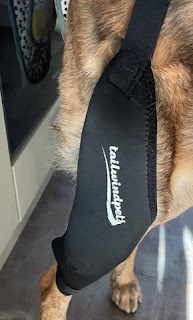In
recent years, the demand for personalized care for our furry companions has
surged. Just as humans benefit from customized medical solutions, so do dogs.
Among the various innovations catering to individualized pet care, personalized
dog knee braces have gained significant attention. These dog braces are designed
to address the specific needs of each dog, providing tailored support for knee
injuries or conditions. In this article, we explore the intricacies of
personalized knee braces for dogs and their importance in canine healthcare.
Understanding
Canine Knee Injuries
Before
delving into the realm of personalized knee braces, it's essential to grasp the
common knee injuries affecting dogs. Canine knee injuries, such as anterior
cruciate ligament (ACL) tears, patellar luxation, or meniscus tears, can cause
significant discomfort and mobility issues for our four-legged friends. These
injuries often require medical intervention to alleviate pain and restore
function.
Challenges of
Standardized Braces
Traditional
off-the-shelf knee braces for dogs may provide some level of support, but they often fail to
address the unique anatomical and biomechanical differences among dogs. Dogs
come in various sizes, breeds, and activity levels, making it challenging to
create a one-size-fits-all solution. Standardized braces may not offer the
precise fit and support required for optimal healing and comfort.
The Advent of
Personalized Dog Knee Braces
Personalized
dog knee brace
represents a breakthrough in veterinary orthotics. These dog braces are
custom-designed to fit the individual dog's leg anatomy, taking into account
factors such as leg length, muscle mass, and joint alignment. By utilizing
advanced technologies like 3D scanning and modeling, veterinarians and
orthotists can create braces that perfectly conform to each dog's unique shape
and requirements.
Benefits of
Personalization
The
personalized approach offers several advantages over standardized braces.
Firstly, it ensures a proper fit, minimizing the risk of discomfort, chafing, or
restricted movement. Secondly, personalized braces can provide targeted support
to the injured area, promoting effective healing and rehabilitation.
Additionally, the customization allows for adjustments as the dog progresses
through recovery, accommodating changes in swelling, muscle tone, or gait
patterns.
Tailoring
Support for Different Conditions
One
of the key strengths of personalized dog knee braces is their versatility in addressing various knee conditions.
Whether a dog is recovering from surgery, managing a chronic condition, or
simply in need of extra support due to aging or injury, a personalized brace
can adapt to the specific requirements of each case. This adaptability enhances
the overall effectiveness of the treatment and improves the dog's quality of
life.
Collaboration
between Veterinarians and Orthotists
Effective
utilization of personalized dog knee brace
hinges on a collaborative effort between veterinarians and orthotists. Veterinarians
evaluate the dog's condition, devising tailored treatment plans, and offer
essential insights into brace design. Orthotists leverage their expertise in
biomechanics and orthotic crafting to develop braces that not only adhere to
the veterinarian's guidance but also prioritize the dog's comfort and mobility.
This synergy ensures the optimal fit and functionality of the braces, enhancing
the canine's well-being and recovery journey.
Case Studies
and Success Stories
Numerous
case studies and success stories highlight the efficacy of personalized dog knee braces in improving canine
mobility and well-being. From active working dogs to beloved family pets, dogs
of all breeds and sizes have benefited from customized orthotic solutions.
These stories underscore the transformative impact of personalized care on the
lives of both dogs and their owners.
Conclusion
Personalized
dog knee brace
represents a significant advancement in veterinary orthotics, offering tailored
support for dogs with knee injuries or conditions. By addressing the individual
needs of each dog, these braces enhance comfort, promote healing, and improve
overall mobility. As the demand for personalized pet care continues to grow,
personalized orthotic solutions are poised to play a vital role in optimizing
canine health and happiness.










